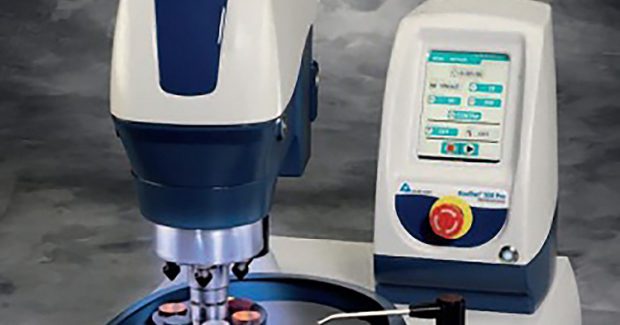Grinder-Polisher Improves Consistency and Repeatability in Materials Analysis, Testing
The programmable EcoMet 250/300 Pro Grinder-Polisher with AutoMet 250/300 Power Head from Buehler features semi-automatic operation to increase consistency and repeatability, with new functions for method optimization.
Posted: February 4, 2011
The EcoMet® 250/300 Pro grinder-polisher with AutoMet® 250/300 power head from Buehler (Lake Bluff, IL) offers the ability to store and recall 32 methods via touch screen controls, a Z-axis function that removes material by depth instead of time and platen, and power head speeds that adjust in 10 rpm increments. The EcoMet 250/300 Pro/AutoMet 250/300 semi-automatic system, with its programmable and adjustable functions, increases consistency and repeatability, ensures better flatness and enables method optimization compared to manual grinding. The optional PriMet® Pro modular dispensing satellite uses peristaltic pumps, not mist technology, to distribute lubricant, diamond, alumina and colloidal polishing suspensions. Controlled dispensing offers repeatable results regardless of the operator, and it can lower consumables costs by preventing over-use.
The EcoMet is also available in a non-programmable version with push-button controls and digital readouts. While they also allow manual sample preparation, EcoMet Pro/AutoMet semi-automatic grinder/power head systems provide several tools that help increase consistency and repeatability. For example, semi-automatic material removal helps ensure better flatness (critical when making measurements) because it eliminates hand rocking, while the Z-axis function enables targeting a specific plane.
“After determining the average depth of material needed to be removed to reach the damage-free/stress-free section, personnel can program the EcoMet Pro to remove a specific amount of material, rather than programming it by time,” says Andrea Johnson, a Buehler product manager who notes that testing and lab personnel believe that they must have a “hand touch” to prevent over-preparing a sample. Unfortunately, manually prepared samples often have planar issues and exhibit variations between samples. “To ensure that all specimens are prepared using the same method — and to save time — use the EcoMet’s programmable function to store up to 32 of methods and instantly recall them,” she adds.
Additional benefits of semi-automatic systems include variable speed adjustments that provide the flexibility to custom tailor methods to the type and hardness of a sample. Higher speeds impact the abrasive very aggressively, while slower speeds are gentler on the sample.
The EcoMet 250 Pro/AutoMet 250 system features platen speeds of 10 rpm to 500 rpm and power head speeds 30 rpm to 60 rpm (both adjustable in 10 rpm increments), as well as a central specimen force of 5 lb to 60 lb (20 N to 260 N) and single specimen force of 1 lb to 10 lb (5 N to 45 N). The system features platen speeds of 10 rpm to 400 rpm and power head speeds of 60 rpm to 150 rpm (both adjustable in 10 rpm increments), a central specimen force of 10 lb to 120 lb (40 N to 535 N) and single specimen force of 1 lb to 20 lb (5 N to 90 N). Operating parameters, such as speed and force, are adjustable during the preparation sequence. A pause function allows the operator to stop operation during a step, remove a sample for examination, and then complete that step at a later time.
“The range covered by these machines enables use for preparing small, fragile, multi-composition parts, large, unmounted welds or anything in between,” notes Johnson.
Buehler, 41 Waukegan Road, Lake Bluff, IL 60044, 847-295-6500, info@buehler.com, www.buehler.com.




